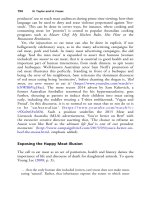The palgrave international handbook of a 486
Bạn đang xem bản rút gọn của tài liệu. Xem và tải ngay bản đầy đủ của tài liệu tại đây (37.45 KB, 1 trang )
488
R. Hediger
texts about Chips’ early engagement in war. Lemish tells it this way: Chips
and his handler John P. Rowell were patrolling a beach in Sicily in the early
morning when ‘what appeared to be a small grass-covered hut’ proved in fact
to be ‘a camouflaged pillbox’. When a ‘machine gun opened fire’,
Chips broke loose from Rowell, trailing his leash and running full-steam
toward the hut. Moments later, the machine-gun fire stopped and an Italian
soldier appeared with Chips slashing and biting at his arms and throat. Three
soldiers followed with their arms raised in surrender.
But just a sentence after presenting this assured version of the story,
Lemish recognizes the limits of our firm knowledge about this episode:
‘What actually occurred in the pillbox is known only by the Italians and,
of course, the dog’ (1996, pp. 74–75). Nonetheless, Chips’s fame grew later
that night when he was reported to have alerted to ‘ten Italian soldiers
approaching on the road’ (Lemish 1996, p. 75).
Chips’s vigorous and seemingly voluntary participation was key to his
designation as a hero dog. But how voluntary was Chips’s behavior in this
scenario? Kistler’s account of this story differs significantly from Lemish’s.
Kistler writes that
Rowell unleashed Chips and ordered him to attack. Chips charged, and
was hit by several bullets, yet knocked one machine gun over, burning his
hair on the hot barrel, then grabbed the gunner by the throat and ripped
out his jugular. The other two Italians fled and were shot by American
troops. (2011, pp. 28–29).
While the injuries to Chips are similar in both accounts, several points of
emphasis in the stories differ, including just what exactly the dog did to the
Italians and who really initiated the action in the first place—Chips or
Rowell.
From these sources, it is therefore difficult to conclude when or if Chips’s
participation in the war effort becomes abuse. At issue is partly the nature/nurture
question: to what extent is such protecting and attacking behavior natural, and to
what extent is it motivated by human intervention? As I argue in the introduction
to Animals and war, this set of questions quickly grows complex and vexed, and is
finally beyond the scope of this chapter (2013, pp. 3–5 and passim).
Even if one believes Chips was an entirely willing participant in war, far
too many unambivalent cases of abuse and violence toward dogs exist. For
instance, after World War I concluded, Lemish writes,









